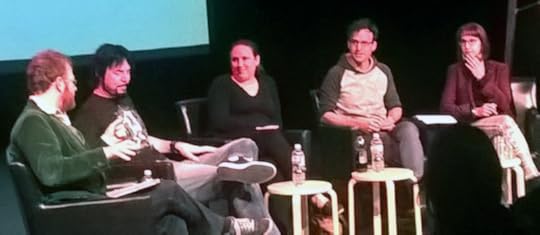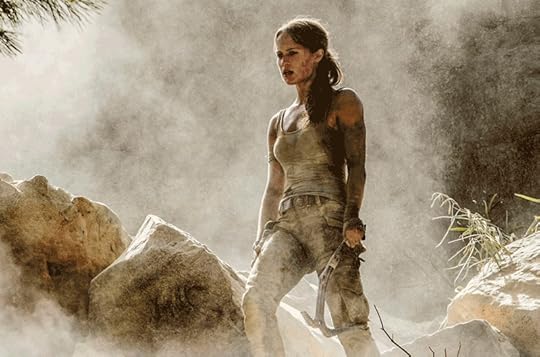S.K. Dunstall's Blog, page 21
May 12, 2018
Eurovision 2018

This is the tag line for Catherynne M. Valente’s new novel, Space Opera. This is from the front cover.
Catherynne M. Valente has introduced a lot of people to the Eurovision this year with her new novel, Space Opera, which is effectively Eurovision in Space.
By the time you read this the Eurovision Song Contest 2018 will probably be over. The final will be held Sunday morning, Australian time.
Here in Australia we see the contest on Sunday night. Sherylyn and I try to avoid spoilers throughout the day, then sit down at night and score each entry. We seldom pick the winner. In fact, the ones we like often score very low.
Normally I go through the songs and pick out the power ballads. I’m a sucker for power ballads. This year there weren’t many. The closest I could find was Azerbaijan.
I rather liked the Azerbaijan entry (singer, Aisel). It’s one of those songs you like better every time you hear it.
Unfortunately, they didn’t make it past the first semi-final. A pity.
The other song I really like is Estonia’s entry (singer Elina Nechayeva). I don’t think it has a chance of winning, but listen to Elina’s voice.
Plus, she deserves extra points for that dress.
May 5, 2018
Paper newspapers and magazines help generate stories
I’ve three old, screwed-up paper serviettes in my bag. I can’t throw them out, because I’ve written on them, and because I come home from work and dump my bag and don’t look into it until the next day. As a result these little notes remain until I remember them. After which they stay on my desk for a few weeks until I finally get around to putting them onto the computer.
They’re my story ideas.
They’re the ideas that I have while I’m out, where I snatch the nearest thing to hand and scribble down the fragment that comes to mind.
The thing is, I often have these ideas while I’m out, at breakfast, reading the newspaper.
I get most of my news online now. I read the news online, have a number of news sites that I visit, but that only gives you the news you choose to read. Printed newspapers are, and always have been, a major source of ideas for me. For both of us.
That and printed magazines. I used to regularly buy the New Scientist and Scientific American magazines, just for the ideas. Now I look at that online too.
Nowadays, the only time I look at newspapers is when I’m out. Cafes, at breakfast time, are the main places I read on paper now.
There’s something about reading a printed news source. Your eye catches an article—something you wouldn’t even think to read normally. Eye-brain triggers something. An idea pops into your head.
Quick, where’s the notepad? Haven’t got it? Anything will do. What about a spare paper napkin?
Which is how I come to have so many scribbled notes in my bag, waiting to be transferred to the computer.
Of course, my handwriting is so bad, by the time I come to transfer them, there are always a couple of words I have to guess, because I have no idea what I wrote. But sometimes that simply adds to the idea.
April 28, 2018
Speculate 18

From the Dungeons & Development: Character Under Pressure panel
From left to right: Ben McKenzie (moderator) and dungeon master (and dragon), Jay Kristoff, Amie Kaufman, Andrew McDonald and Brooke Maggs.
I didn’t get a picture of the band, there were too many heads in the way. The band leader was Maize Wallin (maizewallin.com). Unfortunately, I also didn’t write down the names of the band members, either. (I didn’t write anything, to be honest, but I took a photo of the intro slide, so at least I can name the speakers.) Music and effects were great.
Yesterday I went to the Speculate 18, which is a speculative writers’ festival, held here in Melbourne.
It was pretty good.
As festivals go, it was small. One stream, five sessions. But they were good sessions. Three in the morning, two in the afternoon.
The most fun session was the first one after lunch. Dungeons & Development: Character Under Pressure where our four panel members and the moderator did a D&D role play live on stage, with a band to add sound effects on the side.
It was lots of fun, and the dynamic between everyone worked really well.
I couldn’t pick a standout session in the more serious topics. They were all uniformly good, and I liked bits from all of them.
Two of my personal favourite bits were from Science Fiction: The Past, the Present, and What’s to Come. One was Dirk Strasser’s summary of the current state of science fiction. The most popular trends at present, he says, are climate fiction, generation ships, space opera, and gender themes. Plus Laura Goodin’s point that back in the Victorian era, genre didn’t exist. Writers like Dickens happily wrote across genres.
The audience questions from this session led to some really thought-provoking answers, too. One audience member asked whether the pace of scientific change would make science fiction irrelevant. No, Laura Goodin says, science fiction is a lens by which we see ourselves through fiction.
I have to agree with her.
A lot of people get this idea that science fiction is only about the science, and that somehow there’s no science left to discover.
I think most of us would agree that’s not true. Sure the mobile phones, artificial intelligence and self-driving cars and other things dreamed about in the forties, fifties and sixties are finally here, or nearly here, and the rate of change of some of these things has increased almost exponentially, but what about genetics? What about climate control? What about massive ocean farms?
Plus, science fiction isn’t really about science. It’s about people. As Laura said, it’s a way to see ourselves. Fahrenheit 451 is still just as relevant today as it was when Ray Bradbury wrote it, even if instead of burning books they’re burning data stores. The Handmaid’s Tale shows us a bleak, dystopian future.
Science fiction is still doing what it set out to do. Entertain us, but also make us think.
The audience questions on all panels were good. (Kudos, too, to how they kept the questioners on track. No statements, just questions.) A question on an earlier panel sparked a discussion about the things writers take out of their books. (What Sherylyn and I call our pet words.) Sadly, that got cut off because we’d run out of time.
Now, we just have to go back to our own manuscript and check for ‘somehow’. Which is, as was pointed out, a lazy way of having something happen without the author having to explain it.
Sherylyn (who came along, too), pulled her notebook out at the start of the second session. She started writing, and kept writing through the whole of session one.
“You took some comprehensive notes there,” I said, while they set up for the next session.
“Not notes,” she said. “The first thing they said, about describing the woman walking down the street. This whole idea popped into my head. I had to write it down.”
All in all, it was a good day. I was exhausted by the end, I admit. Five sessions were enough.
April 21, 2018
Japanese versions of Linesman
The Japanese versions of Linesman arrived in the mail the other day.
They’re so tiny and cute. Smaller than a paperback and half as thick.
Look at the covers. If you put them together, as we have above, they combine to make one long picture.
With the help of Google translate and a helpful reader (thanks Elizabeth) we’ve worked out that the book is called Starship Eleven in Japanese, and we think that one version is less complex than the other. (Blue dot is simpler, possibly)
The cover illustration is by K. Kanehira. The cover design is also credited, but sorry, awesome cover design person/people, we can’t read your name, and we don’t know how to get the name from the book to screen.
Likewise, we’re not too sure who the translator is. Google Translate gives us Triangular Kazuyo. Hmm. That might be right, but we think we’ll have to confirm this. More as we find out. If anyone knows, please let us know.
April 14, 2018
Progress report
I pulled a muscle in my back this morning while cleaning the bath. I’d like to say it’s living proof that writers shouldn’t do housework, but unfortunately the reality is that this particular writer hasn’t been doing enough of anything active, housework included, to keep herself supple. Many writers are notoriously bad at keeping fit.
So while I wait for the Nurofen to kick in, let me tell you what’s been happening in our writing world lately.
We’re making good progress on the next batch of rewrites for Stars Book 2. It has a current, tentative title of Stars Beyond. We don’t know if that’s set in concrete. We’re at that stage in writing where every change we’re making is a positive change. “This will sound better if we do this,” or “If we move that section down past here the timeline will flow better.” Of course, some of those changes have flow-on effects, but that’s the way it is with rewrites.
We’re heading toward the deadline. We have to deliver the novel in six weeks.
Based on prior novels, there’ll probably a couple of obvious issues we discover really late. It’s amazing how you can go over a book ten, twenty times and still not see something so obvious until the last minute. Sometimes you can’t see it then, either, and your agent or your editor has to point it out to you.
Sigh.
In other news. The ARCs for Stars Uncharted have started going out to book bloggers and reviewers. The publisher has given some away on Goodreads. Keep an eye on the giveaways there if you want a copy, as we don’t always know about these when they happen so we don’t publicise them.
We’re busy putting the finishing touches to our April newsletter. This will include the first chapter of Stars Uncharted, so it’s going to be mammoth. Chapter one’s pretty long, so we’re trying to pare down the newsletter to a reasonable size. We’re getting there. Slowly.
April 7, 2018
Tomb Raider was worth seeing

Image courtesy of the official Tomb Raider movie site. http://www.tombraidermovie.com
We went to see Tomb Raider on the weekend. I have to say, I liked it.
I didn’t love it the way I loved, say, Wonder Woman, but I thought the movie was quite strong and I enjoyed it. (I’m a supporting member of WorldCon this year and I already know which movie I’m going to vote for. Wonder Woman.)
The story line for Tomb Raider worked. It was solid, if a tad predictable. There were no massive plot holes where you thought what? How? Everything made sense. I particularly liked the ending, where they solve the puzzle not by supernatural means but by science.
I preferred this version way more than the 2001 version.
Probably the silliest bits were those that obviously came from the computer game. The floor falling apart around them while they tried to solve the puzzle, or sliding under the massive metal grates just in the nick of time. Don’t get me wrong, I love these things in computer games, but they don’t translate well to the screen. You really have to suspend disbelief to believe that someone will go to all that trouble to kill tomb robbers.
Alicia Vikander made an excellent Lara Croft. A believable one, too.
It was rather like settling down with an author you know, who reliably always turns out books you enjoy.
They left it open for a sequel. I’m looking forward to the next one.
March 31, 2018
If you don’t have a life-changing book, what do you remember reading?
I’ve been thinking the blog I wrote a couple of weeks ago, about how when you read a book at the wrong time it doesn’t appeal, but if you read it at another time, you love it.
I was a voracious reader, but I was never one of those people who as a teenager found a book that changed my life. I have friends who did, but my childhood reading was a blur. It was a mix of the old books we had around the house—Enid Blyton, the Bobbsey Twins, Hardy boys when we were younger.
Later it was Ivan Southall, Claire Mallory, Mary Elwyn Patchett and Mary Grant Bruce.
A lot of these books were written before I was born. I think I remember them because they were what we had on the bookshelves at home. Our whole family were voracious readers. I’m sure Mum and Dad scoured second-hand shops for us, for we had books from the early 1900s to those of the current day. (I remember a most glorious early edition of Ethel Turner’s Seven Little Australians, from about the 1920s. It was a beautiful book and we read it to bits.)
As for science fiction, I read it all. Not counting the Simon Black books (which we had at home), most of these I got from the library. I know I read the big names. Robert Heinlein, James Blish, Isaac Asimov, Arthur C. Clarke, John Wyndham, Poul Anderson, Philip K. Dick, Larry Niven, but I don’t always remember their stories.
I remember pieces of them, like the start of Heinlein’s Orphans of the Sky, but sometimes I only remember the covers. The brown triffid on Wyndham’s Day of the Triffids, the yellow Gollancz hard covers from the school library.
Isaac Asimov was probably the one writer I remember well, and still re-read. Who can forget Nightfall? Or Elijah Baley in Caves of Steel? Or even The Stars, Like Dust (but don’t get me started on the McGuffin they were chasing).
What surprises me is the early books that stay in mind are (mostly) those I read as an adult. Not only that, there’s a high proportion of women writers among them. Anne McCaffrey, Andre Norton, C. J. Cherryh, Joan D. Vinge. (Norton I read earlier.)
I’d add Asimov and Charles Sheffield in there as the only male writers whose work I actively remember from my childhood/early adulthood.
I remember a lot more of the modern stories I read.
March 24, 2018
Worlds colliding. What happens when your imaginary worlds bleed together?
Sherylyn is editing Stars Book 2.
“They jumped through the void,” she said to me last night. “They can’t do that.”
“Yes, they can,” I reply. “They’re escaping. I know we talk about external forces here, but we’ve set it up so they can jump. Here, and here.”
“They jump. Through the void,” she said to me again. “In fact, I checked, and through the whole book they jump through the void four times.”
I didn’t get it.
“Tell me about the void,” Sherylyn said.
“Well, it’s this massive anomaly in space and … they shouldn’t be jumping through it.”
“No. That’s the vortex. Tell me about the void.”
Other than the fact that our naming convention is a little stupid? I mean, who names two important things like that so similarly?
“Well, it’s hyperspace, and you have to jump through it. Faster than light, you know.”
She knows all this, she designed the galaxy with me. What am I missing?
“… and you use line nine to enter it and line ten to move you while you’re in there and … that’s in the Linesman universe and Stars Uncharted and its as-yet-unnamed sequel is not part of the Linesman series.”
“So what do they do when they what to travel faster than light?”
“They nullspace.”
Mumble, mumble, goes back to change it, finds Sherylyn has already done so.
Keeping the worlds apart
Stars Uncharted is not part of the Linesman universe. One series has linesmen, and world governments. The other has body modders and worlds controlled by companies.
We tried to make the experience of the two galaxies as different as we could. In one series they open their comms (often swiping on and later off) to talk. The comms system works via line five. In the other they link in to a network that’s available galaxy-wide. In Linesman we used lines for faster than light travel, in Stars Uncharted they nullspace. If you get badly burned in Linesman, you have regen on the affected area. It takes a bit of time. In Stars Uncharted they pop you into a genemod machine and you come out in a couple of hours better than new. (The role of the doctor changes, as a result.)
Some things we kept the same. Gravity on ships, for example. Screens of data. Ships that can be any shape, because they don’t normally land on worlds, their shuttles do.
But we try very hard to keep the world building separate.
Sadly, it still creeps in.
It’s another round of editing we need to do. “Does this work in this universe, or is it valid for the other one?”
Let’s see how well we do.
March 17, 2018
Timing is everything when you’re finding books
I knew I was in trouble when I checked the time on my iPad. 2:59. I’d planned on going to sleep early.
It had been an exhausting day, physically and emotionally. I’d come home early, and the first thing I’d done was lay down and power nap. Only ten minutes, but it helped. Until around 9:00pm, when I could hardly hold my eyes open at the computer screen.
“I can’t stay awake,” I said. “I’m going to bed.”
I took my iPad to bed with me. Ten, fifteen minutes of relaxing reading would help, I thought.
It was only when the iPad flashed up the 10% battery warning that I looked at the time. And how much I had left of the book. I was somewhere between 70 and 80% done.
And I had a full day planned the next day.
To be honest, if the following day was a work day, I’d have watched the time more carefully, but it wasn’t, and I didn’t.
After that it became a race against time. Me finishing the book before the iPad ran out of battery.
I won. The battery was on 6% when I finally read the end at 4:02am.
The book I was reading. Joe Abercrombie’s Red Country.
I’ve had the book three years now. I’ve picked it up a couple of times, put it down, picked it up again. The silly thing is, I’ve always loved the idea of it, but … it was never appealing enough to read more than the first chapter.
Sometimes there’s a right time to read a book. Read it at another time and you might find it okay, or meh, but you probably won’t love it. Read it after reading too many similar books in a row and it won’t impact either.
This was the right time for that book.
March 10, 2018
A history of migration in a suburb through its food

This little cafe makes the best bibimbap in the district. It’s fresh, it’s tasty. It’s delicious. They also do the spicy edamame beans (chilli, garlic, rosemary and salt) pictured on the home page.
When we were children, Chinese food sold in restaurants was a very Australianised version of Cantonese cuisine. Fried rice, beef with black bean sauce, lemon chicken, sweet and sour pork (the dish with pineapple). All of them were modified for the Western palate. I mean, chilli in your dish—I can’t even think of a dish that contained it. As for non-Chinese Asian cuisine, we didn’t even know it existed.
The area where we live is sandwiched between a TAFE (Technical and Further Education) college and a large shopping centre (shopping mall).
Back when we first moved here our little main street shopping strip had a newsagent, a post office, a fruit shop, a liquor shop, an Italian restaurant, a bakery, a mini-market and Chinese take-away. Across the road the big suburban pub (and I mean one of those monster ones you could practically land a plane in) served modern Australian cuisine. Think steaks, schnitzels, fish and chips.
When we moved here, the shopping centre was taking away all the business from the fruit shop, the mini-mart and the liquor store.
They closed. So did the Italian restaurant. The newsagent and the post office amalgamated.
At the same time we were in the middle of an international education boom. Universities and TAFEs were actively recruiting overseas students, because of the money they brought in.
As the shops closed, little restaurants started to open in their place. They were aimed at the students. Eel congees (in fact, congees in any shape or form), more soups, less stir fry.
You could tell the nationalities going through the TAFE by the shops that opened. Indonesian first. Then Korean. We learned to love es teler, then bibimbap.
Some cuisines passed us by altogether. Other suburbs were learning to love pho, rice paper rolls, green curry and pad thai. For us it was kim chi and Hainese chicken rice.
Some years ago the government changed the laws regarding TAFEs. They now had to compete directly with universities, whereas prior to this they had mostly acted as an entry-level to the universities, where the students would come and do a two-year diploma, while improving their English, and then move on to the universities.
The students started moving out.
At the same time, Melbourne (and the rest of Australia) were in the middle of a massive housing boom. As the more exclusive suburbs were priced out of most people’s affordability range, suburbs like ours started to become popular with young families looking to buy their first home.
The restaurants changed to suit.
Chinese restaurants are opening now, but it’s not Cantonese cuisine this time, it’s Szechuan (or Sichuan if you spell it that way). Try dry-fried green beans with its mouth-puckering Szechuan pepper. Or Szechuan chicken. (Love the beans by the way, used to eat them all the time. I thought they were healthy. I mean, fresh green beans. Turns out they’re deep fried most of the time.)
There you have it. The lifecycle of a suburb over twenty years, by the changing restaurant scene.









